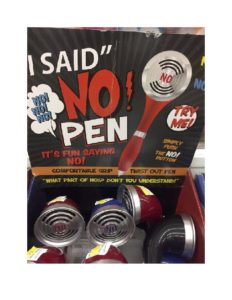Why Saying “No” Is The Fast Food Of Relationships
The act of saying “No” seems to be enjoying a bit of a renaissance these days — one that encourages and even celebrates it as a guilty pleasure. Have you seen the novelty pen out there that actually says it for you? (Check out the tagline in the store display that says “IT’S FUN SAYING NO!”)

What is it about this simple act of refusal that seems so gratifying? Oh, sure, there are lots of reasons thrown around like ridding yourself of the distraction of tasks (and even people) that don’t move you in the direction of your personal life goals, blah-blah-blah, and other self-centered, pop-talk baloney. But there’s also something visceral that puts saying “No” up there with fast food, candy, doughnuts, and other quick-fix indulgences.
What’s the perceived payoff for saying “No”?
- Instant perception of regaining control. It gives us a feeling of control over our destiny. That’s increasingly important and rare in an environment where so many forces compete for our attention. It’s natural to feel that when we say “No” we grab the reins from whoever else is trying to get us to do what they want.
- No follow-up necessary. It has a reassuring finality to it. Think of the enormous popularity of the phrase “We’re done here.” Case closed. Nothing more to do. I’m leaving the situation.
- What about me? It’s a chance to re-assert your own importance as a person amid all the competing voices lobbying for the world’s attention to their agendas.
But what does saying “No” actually communicate to others about your state of mind and intentions:
- Based on what you’ve told me, I’ve decided I’m not willing to help you.
- I don’t want to know any more about it.
- I’m not willing to engage with you any longer.
- I’ve got more important things to do.
- You’ve offended me by even asking.
Do you really want to send these messages? To make matters worse, once the immediate thrill is gone, here’s the message you might be giving to yourself upon a little reflection:
- I took the bait for something that promised a short-term benefit, and reacted (spoke, frowned, shook my head, hit Send) too quickly.
- Maybe I missed an opportunity to help someone who needed it.
- I didn’t give my best effort.
- I didn’t show my best self.
Like most guilty pleasures, the regret and remorse may not be worth the initial kick you get from saying “No.”
Here are 5 quick steps you can take before deciding how to respond to a request:
Inoculate yourself to the pain of saying “Yes.”
Yes, saying “Yes” can be painful because of your anticipation of what’s likely to happen next:
- You’ll be distracted from other things to which you’re already committed.
- You’ll be stepping into the unknown, the unfamiliar and the uncomfortable.
- You’ll take on a load of work, the scope and extent of which may be uncertain.
- You risk failure.
The truth is, none of these concerns may materialize, especially if you recognize that you have within your power a significant amount of influence on what follows.
Resist the urge to respond quickly, even if the other party is communicating a sense of urgency. Don’t decide until you can go through these other steps.
Be a consultant. Imagine you were being asked by the requestor to consult on the best way to address the problem, rather than to perform a task prescribed for you by the requestor. Very few requests for help require a Yes/No decision. Gently challenge the requestor to come up with a plan of action: What do they want to do, how do they propose to accomplish it, what kinds of help do they need. what will they do with the additional help (money or resources) they’re requesting?
Offer something. Is there something you can do, even if it’s not exactly what’s been requested? It may be that you can deliver something completely different from what was requested, but which would actually deliver more value.
Bring in others. Are there other people you could recruit who are better able to assist in the newly-defined problem?
Promise to stay engaged. Chances are, there will be some follow-up help needed. Stay involved with the requestor to check in to see what’s next.
Next time you’re presented with an opportunity to enjoy the fast-food thrill of saying “No,” take a moment to consider this quick alternative process that will be more satisfying to others and to you.
